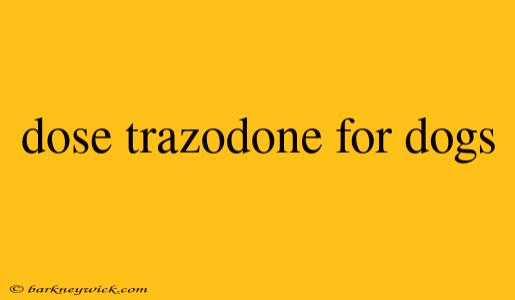Trazodone for Dogs: A Calm and Collected Guide
Have you ever wished your furry friend could just relax and chill out? I know I have! My golden retriever, Max, is a bundle of energy and gets anxious around loud noises, like fireworks. After a particularly stressful 4th of July, my vet suggested trazodone. I was hesitant at first, but after seeing how much it helped Max, I’m a true believer in its potential.
Trazodone is a medication commonly prescribed for dogs to help manage anxiety, fear, and stress. It works by affecting serotonin levels in the brain, which helps regulate mood and behavior. In my opinion, it’s a game changer for anxious dogs, offering a sense of calm without dulling their personality.
Here’s what you should know about trazodone for dogs:
How Trazodone Works for Dogs
Trazodone, a human medication, is used "off-label" for dogs. This means it's not specifically approved by the FDA for veterinary use, but vets commonly prescribe it for certain conditions.
- Anxiety Relief: Trazodone can help calm anxious dogs, reducing stress and fear. It can be particularly helpful for managing separation anxiety, noise phobias, and general nervousness.
- Sleep Improvement: Trazodone can also help improve sleep quality in dogs, especially those experiencing anxiety or stress that disrupts their sleep patterns.
Benefits of Using Trazodone
- Generally Safe and Well-Tolerated: Trazodone is considered safe for most dogs when used under veterinary supervision. It's typically well-tolerated, with minimal side effects.
- Fast Acting: Trazodone typically begins working within 30-60 minutes after administration.
- Variety of Administration Options: Trazodone can be given orally, either as a tablet or capsule, or crushed and mixed with food.
Possible Side Effects and Precautions
- Drowsiness: Trazodone can cause drowsiness in some dogs. Monitor your dog's activity level after administering the medication.
- Gastrointestinal Issues: Some dogs may experience vomiting, diarrhea, or loss of appetite.
- Low Blood Pressure: Trazodone can occasionally cause a drop in blood pressure, which can be a concern for dogs with pre-existing heart conditions.
It’s crucial to consult your vet before giving your dog trazodone. They will assess your dog's individual needs, determine the appropriate dosage, and monitor for any potential side effects.
How to Administer Trazodone
- Follow your vet's instructions: The dosage and frequency of administration will vary depending on your dog's size, weight, and condition.
- Administer with food: Trazodone can cause stomach upset on an empty stomach. Give it with food to minimize this risk.
- Be patient: It may take a few days for the full effects of trazodone to be noticeable.
Tips for Managing Anxiety in Dogs
- Exercise and playtime: Physical activity can help tire your dog out and reduce anxiety.
- Environmental enrichment: Provide your dog with stimulating toys, puzzles, and interactive games.
- Training: Positive reinforcement training can help teach your dog coping skills and reduce anxiety.
- Avoid overstimulation: Limit exposure to loud noises, crowds, and stressful situations.
- Create a safe space: Designate a calm and quiet area for your dog to retreat to when feeling anxious.
Remember, trazodone is a tool to help manage your dog's anxiety, not a magic cure. Combining medication with lifestyle changes and behavioral interventions can provide the best results.
In conclusion, trazodone can be a valuable resource for managing anxiety in dogs. However, it’s essential to consult with your veterinarian to ensure that it’s the right option for your furry friend. Just like Max, your dog can enjoy a calmer, happier life with the right support and guidance.
